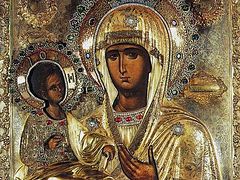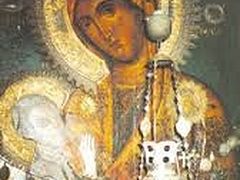Skopje, September 23, 2024
The faithful of the Macedonian Orthodox Church-Ohrid Archbishopric (MOC-OA) filled the streets of Skopje on September 20, processing in honor of the next day’s feast of the Nativity of the Mother of God.
That afternoon, a copy of the wonderworking Icon of the Mother of God of Three Hands, painted by St. John of Damascus and kept at the Serbian Hilandar Monastery on Mt. Athos, arrived in the Macedonian capital, brought by Hilandar abbot Archimandrite Metodij and other members of the brotherhood, reports liturgija.mk.
The icon was festively greeted at Skopje’s Church of the Nativity of the Most Holy Theotokos. The reception was led by the MOC-OA primate, His Beatitude Archbishop Stefan of Ohrid, with three other hierarchs of the Macedonian Church.
Then, a festive Vespers service was celebrated in the presence of the icon, during which a procession was held around the center of Skopje.
The next day, Abp. Stefan presided over the Divine Liturgy for the feast of the Nativity of the Theotokos, together with the other hierarchs, the abbot and other priests from Hilandar, and clerics of the Serbian Orthodox Church from America and Montenegro.
***
The story of the Mother of God of Three Hands:
In the 8th century during the time of the Iconoclasts, St. John of Damascus (December 4) was zealous in his veneration of holy icons. Because of this, he was slandered by the emperor and iconoclast Leo III the Isaurian (717-740), who informed the Damascus caliph that St. John was committing treasonous acts against him. The caliph gave orders to cut off the hand of the monk and take it to the marketplace. Towards evening St. John, having asked the caliph for the cut-off hand, put it to its joint and fell to the ground before the icon of the Mother of God. The monk begged Our Lady to heal the hand, which had written in defense of Orthodoxy. After long prayer he fell asleep and saw in a dream that the All-Pure Mother of God had turned to him promising him quick healing.
Before this the Mother of God bid him toil without fail with this hand. Having awakened from sleep, St. John saw that his hand was unharmed. In thankfulness for this healing St. John placed on the icon a hand fashioned of silver, from which the icon received its name “Of Three Hands.” (Some iconographers, in their ignorance, have mistakenly depicted the Most Holy Theotokos with three arms and three hands.) According to Tradition, St. John wrote a hymn of thanksgiving to the Mother of God: “All of creation rejoices in You, O Full of Grace,” which appears in place of the hymn “It is Truly Meet” in the Liturgy of St. Basil the Great.
St. John Damascene accepted monasticism at the monastery of St. Sava the Sanctified and there bestowed his wonderworking icon. The Lavra presented the icon Of Three Hands in blessing to St. Sava, Archbishop of Serbia (+ 1237, January 12). During the time of an invasion of Serbia by the Turks, some Christians who wanted to protect the icon, entrusted it to the safekeeping of the Mother of God Herself. They placed it upon a donkey, which without a driver proceeded to Athos and stopped in front of Hilandar Monastery. The monks put the icon in the monastery’s cathedral church. During a time of discord over the choice of abbot, the Mother of God deigned to head the monastery herself, and from that time her holy icon has occupied the abbot’s place in the temple. At Hilandar Monastery there is chosen only a vicar, and from the holy icon the monks take a blessing for every obedience.
Follow OrthoChristian on Twitter, Vkontakte, Telegram, WhatsApp, MeWe, and Gab!






